The Role of Energy Communities in the Achievement of a Region’s Energy Goals: The Case of a Southeast Mediterranean Region
Abstract
1. Introduction
2. Literature Review
2.1. Greece’s National Energy Strategy
2.2. Energy Communities in Greece
3. Energy Communities Contribution to a Nation’s Energy Goals
- The environmental aspect of ECs refers to the expected increase in renewable energy share;
- The social dimension of ECs relates to the collaboration and organisation between members of the energy community, as well as the principles that guide such cooperation;
- The economic dimension of ECs relates to the variety of activities energy communities might exercise to match consumption and production at the community level.
3.1. Key Insights for the Achievement of a Country’s Energy Goals
3.2. Energy Communities Impact Within a Region
4. Methodology
4.1. Preliminary Phase
4.2. Fieldwork
5. Results
- ◦
- Supportive policy and regulatory frameworks such as grid access and fair compensation for energy produced by ECs.
- ◦
- Providing grants, low-interest loans, and tax incentives for EC formation and expansion.
- ◦
- Fund research and pilot projects to test innovative energy solutions.
- ◦
- Support local workshops, training programs, and school initiatives to educate communities on sustainable energy practices.
- ◦
- Encourage collaborations between ECs, municipalities, businesses, and universities to share best practices.
6. Discussion
7. Conclusions
- Streamlining the processes for ECs to secure permits and licenses, recognising their distinct characteristics and challenges;
- Establishing or modifying financial incentives and subsidies and offering mechanisms to facilitate access to affordable financing for renewable projects;
- Investing in grid upgrading to facilitate the incorporation of decentralised renewable energy sources from energy communities;
- Establishing a knowledge-sharing platform for ECs to exchange experiences, technical expertise, and best practices;
- Promoting knowledge of the social and environmental advantages of ECs.
Author Contributions
Funding
Data Availability Statement
Conflicts of Interest
References
- Depledge, J. The “top-down” Kyoto Protocol? Exploring caricature and misrepresentation in literature on global climate change governance. Int. Environ. Agreem. 2022, 22, 673–692. [Google Scholar] [CrossRef]
- Seaman, C. Qualitative methods in empirical studies of software engineering. IEEE Trans. Softw. Eng. 1999, 25, 557–572. [Google Scholar] [CrossRef]
- Economidou, M.; Todeschi, V.; Bertoldi, P.; D’Agostino, D.; Zangheri, P.; Castellazzi, L. Review of 50 years of EU energy efficiency policies for buildings. Energy Build. 2020, 225, 110322. [Google Scholar] [CrossRef]
- Höhne, N.; Kuramochi, T.; Warnecke, C.; Röser, F.; Fekete, H.; Hagemann, M.; Day, T.; Tewari, R.; Kurdziel, M.; Sterl, S.; et al. The Paris Agreement: Resolving the inconsistency between global goals and national contributions. In Climate Policy after the 2015 Paris Climate Conference; Routledge: London, UK, 2021; pp. 30–46. [Google Scholar]
- Fetting, C. The European Green Deal; ESDN report; December 2020; ESDN Office: Vienna, Austria, 2020; p. 53. [Google Scholar]
- Eckert, E.; Kovalevska, O. Sustainability in the European Union: Analyzing the discourse of the European green deal. J. Risk Financ. Manag. 2021, 14, 80. [Google Scholar] [CrossRef]
- Von Homeyer, I.; Oberthur, S.; Jordan, A.J. EU climate and energy governance in times of crisis: Towards a new agenda. J. Eur. Public Policy 2021, 28, 959–979. [Google Scholar] [CrossRef]
- Bekker, S. The EU’s Recovery and Resilience Facility: A Next Phase in EU Socioeconomic Governance? Politics Gov. 2021, 9, 175–185. [Google Scholar] [CrossRef]
- Ovaere, M.; Proost, S. Cost-effective reduction of fossil energy use in the European transport sector: An assessment of the Fit for 55 Package. Energy Policy 2022, 168, 113085. [Google Scholar] [CrossRef]
- Karapidakis, E.; Markaki, M.; Kikaki, A.; Yfanti, S.; Nikologiannis, M. Introduction of Electricity Storage and Photovoltaics for an Adequate Self-Sufficiency in Large Building Complexes. WSEAS Trans. Environ. Dev. 2024, 20, 37–45. [Google Scholar] [CrossRef]
- Hafner, M.; Raimondi, P.P. Priorities and challenges of the EU energy transition: From the European Green Package to the new Green Deal. Russ. J. Econ. 2020, 6, 374–389. [Google Scholar] [CrossRef]
- European Climate Law. Available online: https://climate.ec.europa.eu/eu-action/european-climate-law_en (accessed on 20 March 2024).
- European Green Deal. Available online: https://commission.europa.eu/strategy-and-policy/priorities-2019-2024/european-green-deal_en (accessed on 20 March 2024).
- COM/2020/788. COM(2020)788-European Climate Pact. Available online: https://www.eumonitor.eu/9353000/1/j4nvirkkkr58fyw_j9vvik7m1c3gyxp/vlehnympzjsj (accessed on 20 March 2024).
- European Parliament. Directive (EU) 2018/2001 of the European Parliament and of the Council- of 11 December 2018–On the Promotion of the Used of Energy from Renewable Sources; Official Journal of the European Union: Brussels, Belgium, 2018; p. 128. Available online: https://eur-lex.europa.eu/legal-content/EN/TXT/PDF/?uri=CELEX:32018L2001 (accessed on 22 February 2024).
- Terrier, C.; Loustau, J.R.H.; Lepour, D.; Marechal, F. From Local Energy Communities towards National Energy System: A Grid-Aware Techno-Economic Analyisis. Energies 2024, 17, 910. [Google Scholar] [CrossRef]
- Verkade, N.; Hoffken, J. Collective energy practices: A practice-based approach to civic energy communities and the energy system. Sustainability 2019, 11, 3230. [Google Scholar] [CrossRef]
- Romero-Rubio, C.; de Andr es Díaz, J.R. Sustainable Energy Communities: A Study Contrasting Spain and Germany. Energy Policy 2015, 85, 397–409. [Google Scholar] [CrossRef]
- Gui, E.M.; MacGill, I. Typology of future clean energy communities: An exploratory structure, opportunities, and challenges. Energy Res. Soc. Sci. 2018, 35, 94–107. [Google Scholar] [CrossRef]
- Rae, C.; Bradley, F. Energy autonomy in sustainable communities—A review of key issues. Renew. Sustain. Energy Rev. 2012, 16, 6497–6506. [Google Scholar] [CrossRef]
- Dόci, G.; Vasileiadou, E.; Petersen, A.C. Exploring the transition potential of renewable energy communities. Futures 2015, 66, 85–95. [Google Scholar] [CrossRef]
- Heiskanen, E.; Johnson, M.; Robinson, S.; Vadovics, E.; Saastamoinen, M. Low-carbon communities as a context for individual behavioural change. Energy Policy 2010, 38, 7586–7595. [Google Scholar] [CrossRef]
- Frieden, D.; Tuerk, A.; Antunes, A.R.; Vasilakis, A.; Chronis, A.G.; d’Herbemont, S.; Kirac, M.; Marouço, R.; Neumann, C.; Catalayud, E.P.; et al. Are We on the Right Track? Collective Self-Consumption and Energy Communities in the European Union. Sustainability 2021, 13, 12494. [Google Scholar] [CrossRef]
- Blasch, J.; van der Grijp, N.M.; Petrovics, D.; Palm, J.; Bocken, N.; Darby, S.J.; Barnes, J.; Hansen, P.; Kamin, T.; Golob, U.; et al. New clean energy communities in polycentric settings: Four avenues for future research. Energy Res. Soc. Sci. 2021, 82, 102276. [Google Scholar] [CrossRef]
- Margosi, M.; Koukoufikis, G. Fostering Energy Justice through Decentralised Transition: The Case of Energy Communities in Greece. Eur. J. Spat. Dev. 2024, 21, 33–60. [Google Scholar]
- Cucchiella, F.; D’Adamo, I.; Gastaldi, M.; Miliacca, M. Efficiency and allocation of emission allowances and energy consumption over more sustainable European economies. J. Clean. Prod. 2018, 182, 805–817. [Google Scholar] [CrossRef]
- Karmellos, M.; Kopidou, D.; Diakoulaki, D. A decomposition analysis of the driving factors of CO2 (Carbon dioxide) emissions from the power sector in the European Union countries. Energy 2016, 94, 680–692. [Google Scholar] [CrossRef]
- Usman, M.; Ma, Z.; Zafar, M.; Waheed, A.; Li, M. Analyzing the determinants of clean energy consumption in a sustainability strategy: Evidence from EU-28 countries. Environ. Sci. Pollut. Res. 2021, 28, 54551–54564. [Google Scholar] [CrossRef] [PubMed]
- Gökgöz, F.; Güvercin, M. Energy security and renewable energy efficiency in EU. Renew. Sustain. Energy Rev. 2018, 96, 226–239. [Google Scholar] [CrossRef]
- Hoicka, C.E.; Lowitzsch, J.; Brisbois, M.C.; Kumar, A.; Ramirez Camargo, L. Implementing a just renewable energy transition: Policy advice for transposing the new European rules for renewable energy communities. Energy Policy 2021, 156, 112435. [Google Scholar] [CrossRef]
- Clausen, L.T.; Rudolph, D. Renewable energy for sustainable rural development: Synergies and mismatches. Energy Policy 2020, 138, 111289. [Google Scholar] [CrossRef]
- Savaresi, A. The Rise of Community Energy from Grassroots to Mainstream: The Role of Law and Policy. J. Environ. Law 2018, 31, 487–510. [Google Scholar] [CrossRef]
- Hewitt, R.; Bradley, N.; Compagnucci, A.; Barlagne, C.; Ceglarz, A.; Cremades, R.; McKeen, M.; Otto, I.; Slee, B. Social Innovation in Community Energy in Europe: A Review of the Evidence. Front. Energy Res. 2018, 7, 31. [Google Scholar] [CrossRef]
- Matschoss, K.; Mikkonen, I.; Gynther, L.; Koukoufikis, G.; Uihlein, A.; Murauskaite-Bull, I. Drawing policy insights from social innovation cases in the energy field. Energy Policy 2022, 161, 112728. [Google Scholar] [CrossRef]
- European Commission. Renewable Energy Directive 2018/2001/EU. Available online: https://energy.ec.europa.eu/topics/renewable-energy/renewable-energy-directive-targets-and-rules/renewable-energy-directive_en (accessed on 23 April 2024).
- Efthymiou, E.N.; Yfanti, S.; Kyriakarakos, G.; Zervas, P.L.; Langouranis, P.; Terzis, K.; Stavrakakis, G.M. A Practical Methodology for Building a Municipality-Led Renewable Energy Community: A Photovoltaics-Based Case Study for the Municipality of Hersonissos in Crete, Greece. Sustainability 2022, 14, 12935. [Google Scholar] [CrossRef]
- Srivastava, M.; Srivastava, N.; Singh, R. (Eds.) Chapter 8: Pavlos Nikolaidis, Sustainable Routes for Renewable Energy Carriers in Modern Energy Systems. In Bioenergy Research: Commercial Opportunities & Challenges; Springer: Singapore, 2021; pp. 239–266. [Google Scholar] [CrossRef]
- Eurostat. Share of Energy from Renewable Sources. Eurostat. 2022. Available online: https://ec.europa.eu/eurostat/databrowser/view/NRG_IND_REN__custom_13568354/default/bar?lang=en (accessed on 16 May 2024).
- Pertoldi, M.; Fioretti, C.; Testori, G.; De Bruijn, M.; Ferry, M.; Kah, S.; Servillo, L.A.; Windisch, S. Handbook of Territorial and Local Development Strategies; Pertoldi, M., Fioretti, C., Guzzo, F., Testori, G., Eds.; EUR 31263 EN; Publications Office of the European Union: Luxembourg, 2022; ISBN 978-92-76-58445-2. [Google Scholar] [CrossRef]
- Trevisan, R.; Ghiani, E.; Pilo, F. Economic benefits redistribution methodology for renewable energy communities. In Proceedings of the 13th Mediterranean Conference on Power Generation, Transmission, Distribution and Energy Conversion (MEDPOWER 2022), Valletta, Malta, 7–9 November 2022; pp. 213–218. [Google Scholar] [CrossRef]
- Oudeniotis, N.; Tsobanoglou, G. Social financing as a driver for sustainable local development in EU Mediterranean countries. Spain, Portugal, and Greece in perspective. Rev. Appl. Socio-Econ. Res. 2020, 20, 26–40. [Google Scholar]
- Balsalobre-lorente, D.; Leitão, N.; Bekun, F. Fresh Validation of the Low Carbon Development Hypothesis under the EKC Scheme in Portugal, Italy, Greece and Spain. Energies 2021, 14, 250. [Google Scholar] [CrossRef]
- Karapidakis, E.; Koutsourou, K.; Katsigiannis, I.; Yfanti, S.; Iliadis, I. Correlation Analysis of Electricity Prices in Hellenic Wholesale Electricity Market. In Proceedings of the 4th International Conference on Communications, Information, Electronic and Energy Systems (CIEES), Plovdiv, Bulgaria, 26–28 November 2023; pp. 1–4. [Google Scholar] [CrossRef]
- NECP Draft Version. 2024. Available online: https://commission.europa.eu/document/download/83ffdc95-2d22-4c67-8d4c-a3e59f752921_el?filename=GREECE%20-%20DRAFT%20UPDATED%20NECP%202021-2030%20EL.pdf (accessed on 16 May 2024).
- Vourdoubas, J. Possibility of Covering All the Power Demand in the Island of Crete, Greece with Solar Photovoltaics. Eur. J. Appl. Sci. Eng. Technol. 2024, 2, 69–79. [Google Scholar] [CrossRef] [PubMed]
- Hanke, F.; Lowitzsch, J. Empowering vulnerable consumers to join renewable energy communities—Towards an inclusive design of the clean energy package. Energies 2020, 13, 1615. [Google Scholar] [CrossRef]
- Roberts, J. Power to the people? Implications to the Clean Energy Package for the role of community ownership in Europe’s energy transition. Rev. Eur. Comp. Int. Environ. Law 2020, 29, 232–244. [Google Scholar] [CrossRef]
- The Green Tank. Trends in Greece’s Fossil Gas Consumption & Imports—March 2023. Available online: https://thegreentank.gr/en/2023/04/10/gaswatch-mar-en/ (accessed on 30 August 2024).
- IPTO. Original in Greek. Monthly Energy Report. December, Version 2. 2023. Available online: https://www.admie.gr/sites/default/files/attached-files/type-file/2024/02/Energy_Report_202312_v2_gr_0.pdf (accessed on 30 August 2024).
- The Green Tank#4. Original in Greek ‘The Energy Communities in Greece and Lignites Areas #4’. 2023. Available online: https://thegreentank.gr/wp-content/uploads/2023/10/202310_TheGreenTank_Brief_EnergyCommunities4_EL.pdf (accessed on 30 August 2024).
- The Green Tank#5. Original in Greek ‘Energy Communities & Self-Production in Greece and the Lignites Areas #5’. 2024. Available online: https://thegreentank.gr/wp-content/uploads/2024/02/202402_%CE%A4heGreenTank_EnComBrief_5_EL.pdf (accessed on 30 August 2024).
- The Green Tank#6. Original in Greek ‘Energy Communities & Self-Production in Greece and the Lignites Areas #6’. 2024. Available online: https://thegreentank.gr/wp-content/uploads/2024/11/202411_%CE%A4heGreenTank_EnComBrief_6_final_EL.pdf (accessed on 25 February 2025).
- Dorahaki, S.; Rashidinejad, M.; Ardestani, S.F.F.; Abdollahi, A.; Salehizadeh, M. An integrated model for citizen energy communities and renewable energy communities based on clean energy package: A two-stage risk-based approach. Energy 2023, 277, 127727. [Google Scholar] [CrossRef]
- Losada-Puente, L.; Blanco, J.A.; Dumitru, A.; Sebos, I.; Tsakanikas, A.; Liosi, I.; Psomas, S.; Merrone, M.; Quiñoy, D.; Rodríguez, E. Cross-Case Analysis of the Energy Communities in Spain, Italy, and Greece: Progress, Barriers, and the Road Ahead. Sustainability 2023, 15, 14016. [Google Scholar] [CrossRef]
- Trevisan, R.; Ghiani, E.; Pilo, F. Renewable Energy Communities in Positive Energy Districts: A Governance and Realisation Framework in Compliance with the Italian Regulation. Smart Cities 2023, 6, 563–585. [Google Scholar] [CrossRef]
- Wierling, A.; Schwanitz, V.J.; Zeiss, J.P.; von Beck, C.; Paudler, H.A.; Koren, I.K.; Kraudzun, T.; Marcroft, T.; Müller, L.; Andreadakis, Z.; et al. A Europe-wide inventory of citizen-led energy action with data from 29 countries and over 10,000 initiatives. Sci. Data 2023, 10, 9. [Google Scholar] [CrossRef]
- RESCoop. Annual Report 2023—European Federation of Citizen Energy Cooperatives. Available online: https://www.rescoop.eu/uploads/rescoop/downloads/REScoop-Annual-Report-2023_digital.pdf (accessed on 16 May 2024).
- Roberto, R.; Ferruzzi, G.; Negro, V.; Noussan, M. Mapping of Energy Community Development in Europe: State of the Art and Research Directions. Energies 2023, 16, 6554. [Google Scholar] [CrossRef]
- Ahmadifar, A.; Ginocchi, M.; Golla, M.S.; Ponci, F.; Monti, A. Development of an Energy Management System for a Renewable Energy Community and Performance Analysis via Global Sensitivity Analysis. IEEE Access 2023, 11, 4131–4154. [Google Scholar] [CrossRef]
- Gjorgievski, V.Z.; Cundeva, S.; Georghiou, G.E. Social arrangements, technical designs and impacts of energy communities: A review. Renew. Energy 2021, 169, 1138–1156. [Google Scholar] [CrossRef]
- Katsaprakakis, D.A.; Michopoulos, A.; Skoulou, V.; Dakanali, E.; Maragkaki, A.; Pappa, S.; Antonakakis, I.; Christakis, D.; Condaxakis, C. A Multidisciplinary Approach for an Effective and Rational Energy Transition in Crete Island, Greece. Energies 2022, 15, 3010. [Google Scholar] [CrossRef]
- Katsaprakakis, D.A.; Dakanali, E.; Dimopoulos, A.; Gyllis, Y. Energy Transition on Sifnos: An Approach to Economic and Social Transition and Development. Appl. Sci. 2022, 12, 2680. [Google Scholar] [CrossRef]
- Katsaprakakis, D.A.; Proka, A.; Zafirakis, D.; Damasiotis, M.; Kotsampopoulos, P.; Hatziargyriou, N.; Dakanali, E.; Arnaoutakis, G.; Xevgenos, D. Greek Islands’ Energy Transition: From Lighthouse Projects to the Emergence of Energy Communities. Energies 2022, 15, 5996. [Google Scholar] [CrossRef]
- Roberts, J.; Frieden, D.; Gubina, A. ‘Energy Community Definitions’, Compile Project: Integrating Community Power in Energy Islands, No. May 2019. Available online: https://main.compile-project.eu/wp-content/uploads/Explanatory-note-on-energy-community-definitions.pdf (accessed on 16 May 2024).
- Yfanti, S.; Edgar, D.; Temple, B.; Sakkas, N. Innovation and Clustering: Lessons from the Construction sector and Critical Success Factors for adoption and implementation. Lost cause or lacuna? Int. J. Sci. Eng. Investig. 2017, 6, 76–88. [Google Scholar]
- EU Smart Cities Information System. 2020. Available online: https://smart-cities-marketplace.ec.europa.eu/sites/default/files/2022-08/Solution%20Booklet-Energy%20Communities.pdf (accessed on 20 March 2024).
- Kupiec, B. Legal status of a renewables self-consumer under Polish law in light of Directive (EU) 2018/2001 of the European Parliament and of the Council of 11 December 2018 on the promotion of the use of energy from renewable sources. Stud. Pr. Prawnicze Adm. Ekon. 2021. (In Polish) [Google Scholar] [CrossRef]
- Liu, C.; Zowghi, D. Citizen involvement in digital transformation: A systematic review and a framework. Online Inf. Rev. 2022, 47, 644–660. [Google Scholar] [CrossRef]
- Han, Y.; Guo, H. Governmental support strategies and their effects on private capital engagement in public–private partnerships. Public Manag. Rev. 2022, 26, 908–926. [Google Scholar] [CrossRef]
- Uddin, L. Cognitive and behavioural flexibility: Neural mechanisms and clinical considerations. Nat. Rev. Neurosci. 2021, 22, 167–179. [Google Scholar] [CrossRef]
- Mayorga, M.; Hester, E.B.; Helsel, E.M.; Ivanov, B.; Sellnow, T.; Slovic, P.; Burns, W.J.; Frakes, D. Enhancing Public Resistance to “Fake News”. In The Handbook of Applied Communication Research; John Wiley & Sons: Hoboken, NJ, USA, 2020; pp. 197–212. [Google Scholar]
- Yfanti, S.; Apostolaki, M.; Karapidakis, E.; Sakkas, N. Binding EU with national energy policies for sustainability: A trans-boundaries comparative study on public buildings’ energy renovation path. J. Multidiscip. Eng. Sci. Technol 2019, 6, 10421–10431. [Google Scholar]
- Vera, I.; Langlois, L. Energy indicators for sustainable development. Energy 2007, 32, 875–882. [Google Scholar] [CrossRef]
- Santika, W.; Anisuzzaman, M.; Simsek, Y.; Bahri, P.; Shafiullah, G.; Urmee, T. Implications of the Sustainable Development Goals on national energy demand: The case of Indonesia. Energy 2020, 196, 117100. [Google Scholar] [CrossRef]
- Fatima, N.; Li, Y.; Ahmad, M.; Jabeen, G.; Li, X. Factors influencing renewable energy generation development: A way to environmental sustainability. Environ. Sci. Pollut. Res. 2021, 28, 51714–51732. [Google Scholar] [CrossRef] [PubMed]
- Stavrakakis, G.M.; Bakirtzis, D.; Drakaki, K.-K.; Yfanti, S.; Katsaprakakis, D.A.; Braimakis, K.; Langouranis, P.; Terzis, K.; Zervas, P.L. Application of the Typology Approach for Energy Renovation Planning of Public Buildings’ Stocks at the Local Level: A Case Study in Greece. Energies 2024, 17, 689. [Google Scholar] [CrossRef]
- Yfanti, S.; Sakkas, N.; Vailakis, N.; Nistikaki, A. Environmental Sustainability and Regional Competitiveness: Innovative Steps by a Local Public Authority towards Energy Saving. J. Energy Power Eng. 2019, 13, 149–161. [Google Scholar] [CrossRef]
- Brugger, H.; Henry, A. Influence of policy discourse networks on local energy transitions. Environ. Innov. Soc. Transit. 2021, 39, 141–154. [Google Scholar] [CrossRef]
- Otsuka, A.; Goto, M. Regional determinants of energy intensity in Japan: The impact of population density. Asia-Pac. J. Reg. Sci. 2018, 2, 257–278. [Google Scholar] [CrossRef]
- Mehmood, U. Contribution of renewable energy towards environmental quality: The role of education to achieve sustainable development goals in G11 countries. Renew. Energy 2021, 178, 600–607. [Google Scholar] [CrossRef]
- Zhang, Y.; Huang, T.; Yang, D. Impact of firms’ energy-saving effort and fixed asset characteristics on energy savings. J. Clean. Prod. 2020, 268, 122182. [Google Scholar] [CrossRef]
- Lawrence, A.; Thollander, P.; Karlsson, M. Drivers, Barriers, and Success Factors for Improving Energy Management in the Pulp and Paper Industry. Sustainability 2018, 10, 1851. [Google Scholar] [CrossRef]
- Zhang, X.; Zhang, H.; Yuan, J. Economic growth, energy consumption, and carbon emission nexus: Fresh evidence from developing countries. Environ. Sci. Pollut. Res. 2019, 26, 26367–26380. [Google Scholar] [CrossRef] [PubMed]
- Godlewska-Majkowska, H.; Komor, A. Energy as a Factor of Investment Attractiveness of Regions for Agricultural Enterprises. Energies 2021, 14, 2731. [Google Scholar] [CrossRef]
- Lin, J.; Xu, C. The Impact of Environmental Regulation on Total Factor Energy Efficiency: A Cross-Region Analysis in China. Energies 2017, 10, 1578. [Google Scholar] [CrossRef]
- Zhang, D.; Vigne, S. How does innovation efficiency contribute to green productivity? A financial constraint perspective. J. Clean. Prod. 2021, 280, 124000. [Google Scholar] [CrossRef]
- Yfanti, S.; Sakkas, N. Technology Readiness Levels (TRLs) in the Era of Co-Creation. Appl. Syst. Innov. 2024, 7, 32. [Google Scholar] [CrossRef]
- Borozan, D. Technical and total factor energy efficiency of European regions: A two-stage approach. Energy 2018, 152, 521–532. [Google Scholar] [CrossRef]
- Akram, R.; Chen, F.; Khalid, F.; Ye, Z.; Majeed, M. Heterogeneous effects of energy efficiency and renewable energy on carbon emissions: Evidence from developing countries. J. Clean. Prod. 2020, 247, 119122. [Google Scholar] [CrossRef]
- Bashir, M.; Sheng, B.; Doğan, B.; Sarwar, S.; Shahzad, U. Export product diversification and energy efficiency: Empirical evidence from OECD countries. Struct. Change Econ. Dyn. 2020, 55, 232–243. [Google Scholar] [CrossRef]
- Luty, L.; Zioło, M.; Knapik, W.; Bąk, I.; Kukuła, K. Energy Security in Light of Sustainable Development Goals. Energies 2023, 16, 1390. [Google Scholar] [CrossRef]
- Santika, W.; Anisuzzaman, M.; Bahri, P.; Shafiullah, G.; Rupf, G.; Urmee, T. From goals to joules: A quantitative approach of interlinkages between energy and the Sustainable Development Goals. Energy Res. Soc. Sci. 2019, 50, 201–214. [Google Scholar] [CrossRef]
- Karapidakis, E.; Nikologiannis, M.; Markaki, M.; Kikaki, A.; Yfanti, S. Assessment of Batteries’ Contribution for Optimal Self-Sufficiency in Large Building Complexes. Appl. Syst. Innov. 2023, 6, 107. [Google Scholar] [CrossRef]
- Brummer, V. Community energy–Benefits and barriers: A comparative literature review of Community Energy in the UK, Germany and the USA, the benefits it provides for society and the barriers it faces. Renew. Sustain. Energy Rev. 2018, 94, 187–196. [Google Scholar] [CrossRef]
- Ceglia, F.; Esposito, P.; Faraudello, A.; Marrasso, E.; Rossi, P.; Sasso, M. An energy, environmental, management and economic analysis of energy efficient system towards renewable energy community: The case study of multi-purpose energy community. J. Clean. Prod. 2022, 369, 133269. [Google Scholar] [CrossRef]
- Casalicchio, V.; Manzolini, G.; Prina, M.G.; Moser, D. From investment optimization to fair benefit distribution in renewable energy community modelling. Appl. Energy 2022, 310, 118447. [Google Scholar] [CrossRef]
- Cutore, E.; Volpe, R.; Sgroi, R.; Fichera, A. Energy management and sustainability assessment of renewable energy communities: The Italian context. Energy Convers. Manag. 2023, 278, 116713. [Google Scholar] [CrossRef]
- Dal Cin, E.; Carraro, G.; Volpato, G.; Lazzaretto, A.; Danieli, P. A multi-criteria approach to optimize the design-operation of Energy Communities considering economic-environmental objectives and demand side management. Energy Convers. Manag. 2022, 263, 115677. [Google Scholar] [CrossRef]
- Kyriakopoulos, G.L. Energy Communities Overview: Managerial Policies, Economic Aspects, Technologies, and Models. J. Risk Financ. Manag. 2022, 15, 521. [Google Scholar] [CrossRef]
- Backe, S.; Zwickl-Bernhard, S.; Schwabeneder, D.; Auer, H.; Korpås, M.; Tomasgard, A. Impact of energy communities on the European electricity and heating system decarbonization pathway: Comparing local and global flexibility responses. Appl. Energy 2022, 323, 119470. [Google Scholar] [CrossRef]
- Grandclément, C.; Nadaï, A. Devising the consumer of the competitive electricity market: The mundane meter, the unbundling doctrine, and the re-bundling of choice. J. Cult. Econ. 2018, 11, 440–457. [Google Scholar] [CrossRef]
- Biggar, D.; Hesamzadeh, M.R. Energy communities: Challenges for regulators and policymakers. In Energy Communities: Customer-Centered, Market-Driven, Welfare-Enhancing? Academic Press: Cambridge, MA, USA, 2022; pp. 131–149. [Google Scholar] [CrossRef]
- Saunders, M.; Lewis, P.; Thornhill, A. Research Methods for Business Students, 5th ed.; Prentice Hall: Hoboken, NJ, USA, 2009; ISBN 978-0-273-71686-0. [Google Scholar]
- Alasuutari, P. The rise and relevance of qualitative research. Int. J. Soc. Res. Methodol. 2010, 13, 139–155. [Google Scholar] [CrossRef]
- Adler, K.; Salantera, S.; Zumstein-Shaha, M. Focus Group Interviews in Child, Youth, and Parent Research: An Integrative Literature Review. Int. J. Qual. Methods 2019, 18, 1609406919887274. [Google Scholar] [CrossRef]
- Owens, L.L. An Implausible Virtual Interview: Conversations with a Professional Research Subject. Sociol. Methodol. 2022, 52, 121–140. [Google Scholar] [CrossRef]
- Sadaiyandi, J.; Arumugam, P.; Sangaiah, A.K.; Zhang, C. Stratified Sampling-Based Deep Learning Approach to Increase Prediction Accuracy of Unbalanced Dataset. Electronics 2023, 12, 4423. [Google Scholar] [CrossRef]
- Pahkala, T.; Uimonen, H.; Väre, V. Flexible and Customer-Centred Electricity System; Final Report of the Smart Grid Working Group; Ministry of Economic Affairs and Employment: Helsinki, Finland, 2018; Available online: http://urn.fi/URN:ISBN:978-952-327-352-8 (accessed on 30 August 2024)ISBN 978-952-327-352-8.
- ILO. Guidelines for a Just Transition Towards Environmentally Sustainable Economies and Societies for All. 2015. Available online: https://www.ilo.org/publications/guidelines-just-transition-towards-environmentally-sustainable-economies (accessed on 22 September 2024).
- Ypodomes.com. Original in Greek ‘From RES Almost 60% of the Electricity in Greece in 2024’. Available online: https://ypodomes.com/apo-ape-schedon-to-60-tis-ilektrikis-energeias-stin-ellada-to-2024/ (accessed on 30 August 2024).
- Chalkiadakis, G.; Akasiadis, C.; Savvakis, N.; Tsoutsos, T.; Hoppe, T.; Coenen, F. Providing a scientific arm to renewable energy cooperatives. In The Role of Exergy in Energy and the Environment. Green Energy and Technology; Springer: Cham, Switzerland, 2018; pp. 717–731. [Google Scholar] [CrossRef]
- European Electricity Review. Ember’s Analysis of the EU Electricity Transition in 2022: What Happened in 2022, What Can We Expect for 2023? 2023. Available online: https://ember-climate.org/app/uploads/2023/01/Report-European-Electricity-Review-2023.pdf (accessed on 25 August 2024).
- Jones, D.; Brown, S.; Czyzak, P. European Electricity Review 2023. 2023. Available online: https://ember-climate.org/insights/research/european-electricity-review-2023/ (accessed on 16 May 2024).
- Caramizaru, A.; Uihlein, A. Energy Communities: An Overview of Energy and Social Innovation; Vo.30083; Publications Office of the European Union: Luxembourg, 2020. [Google Scholar]
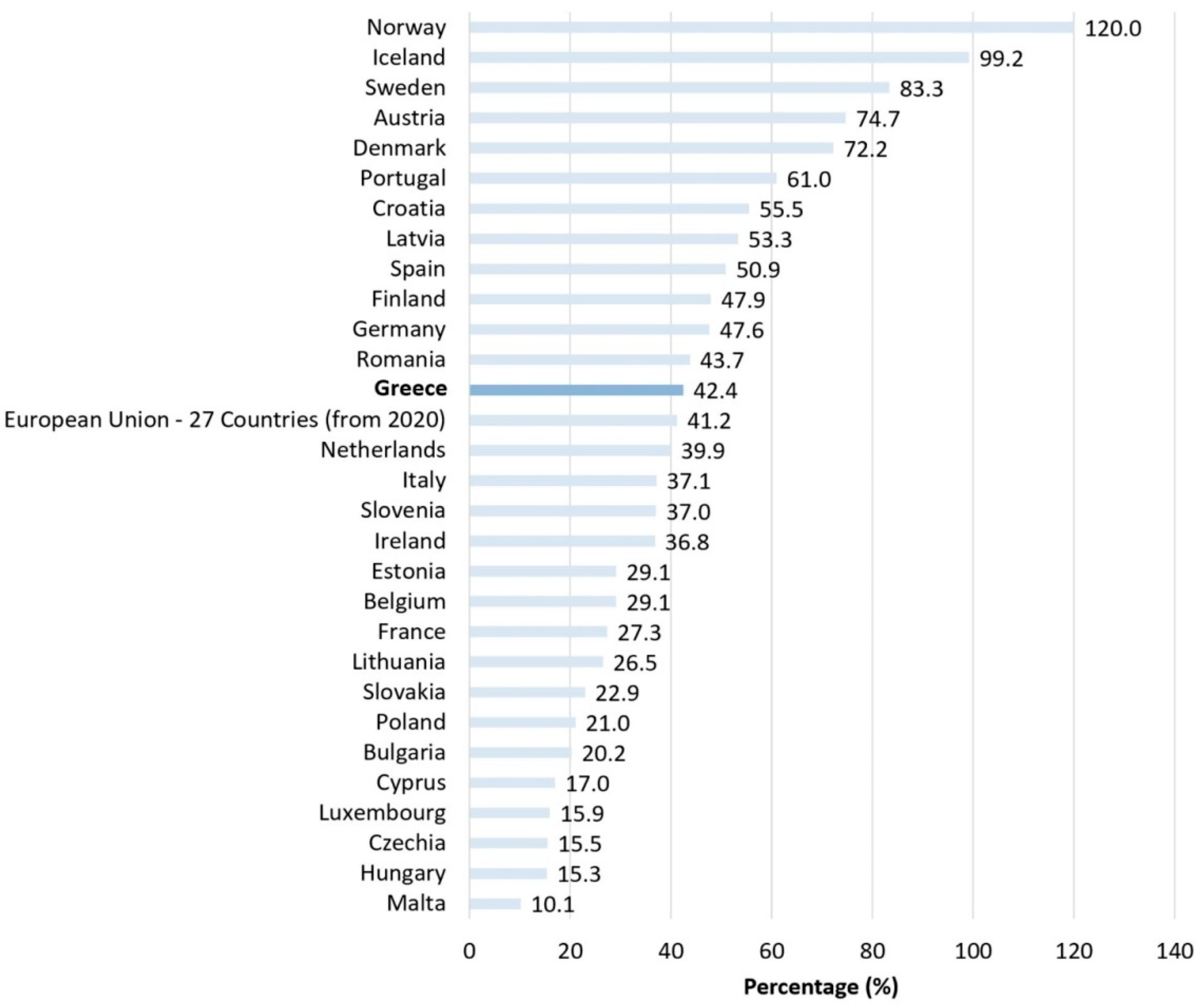

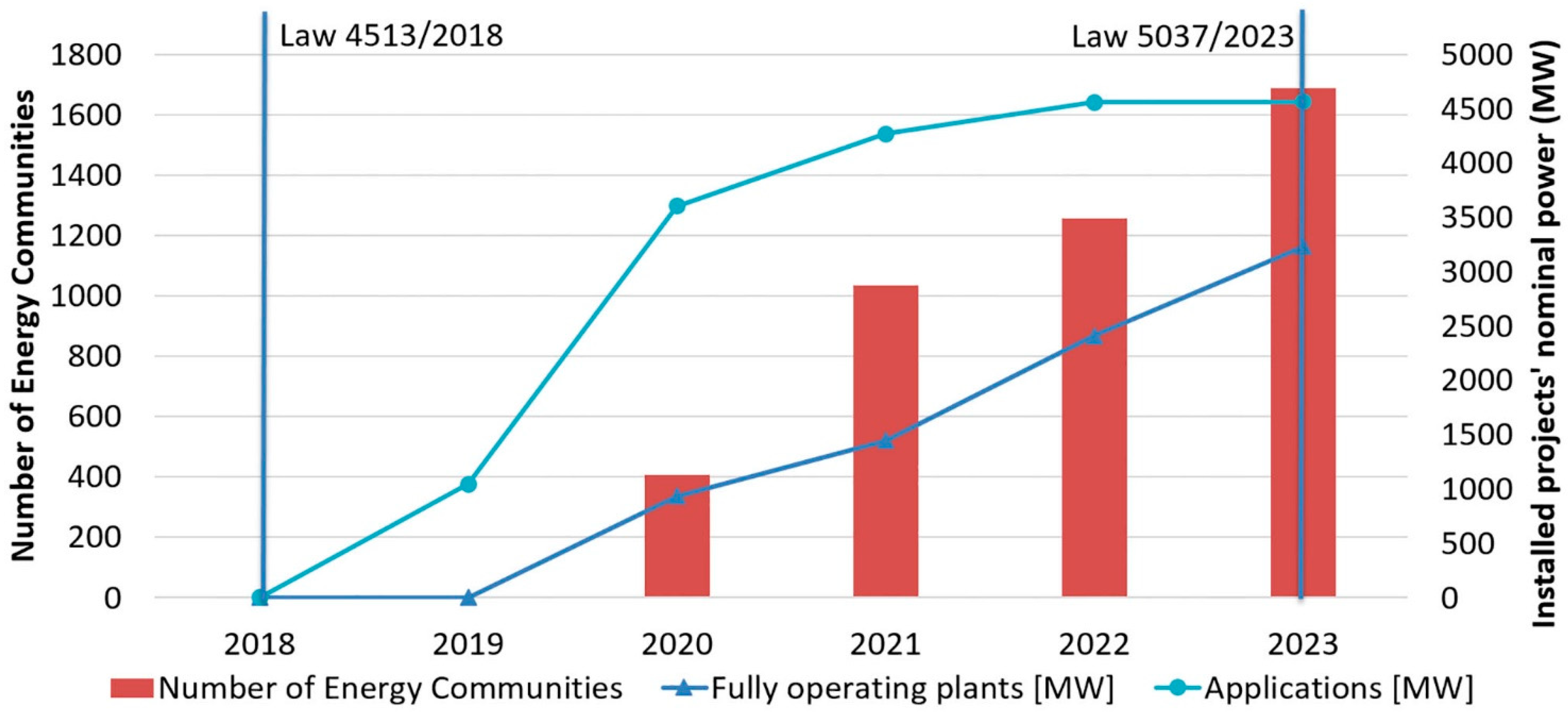
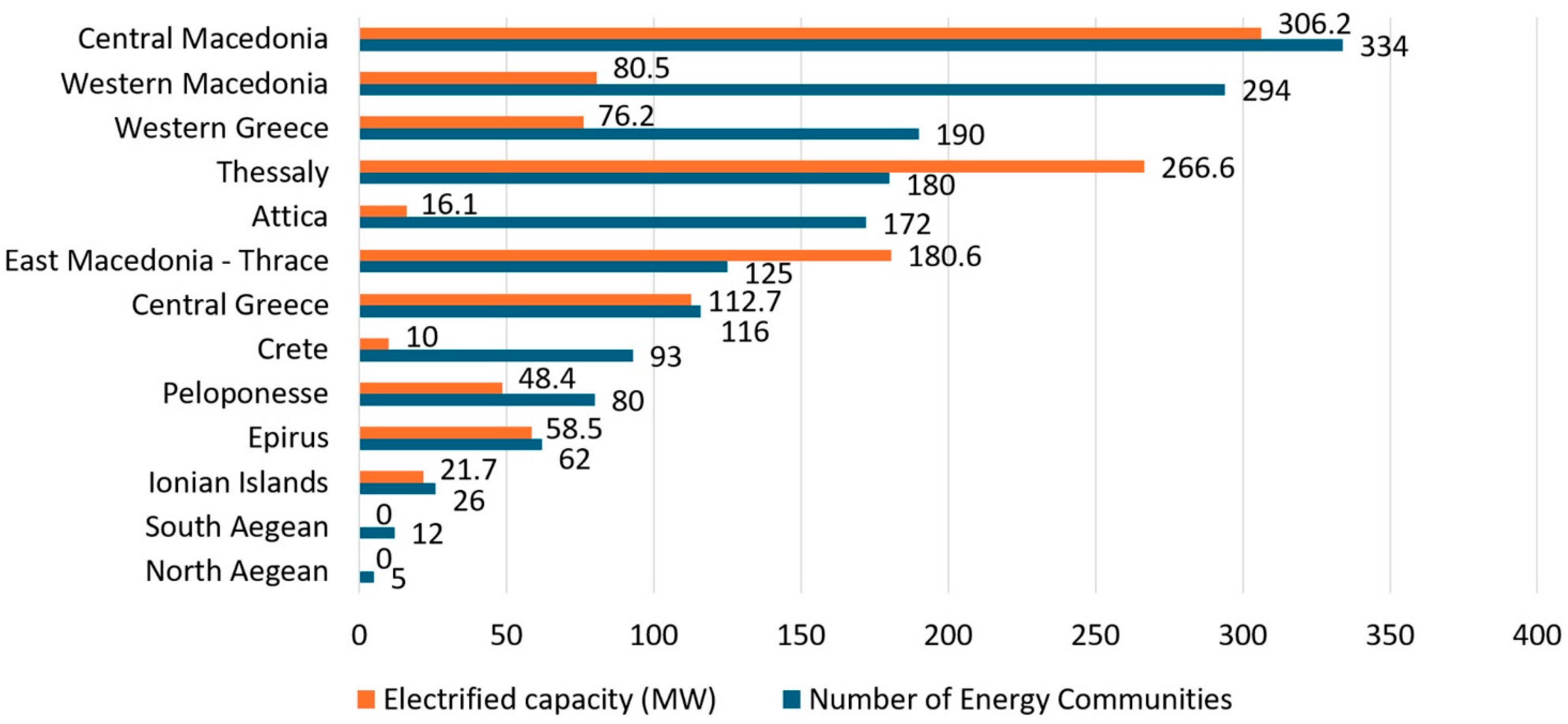


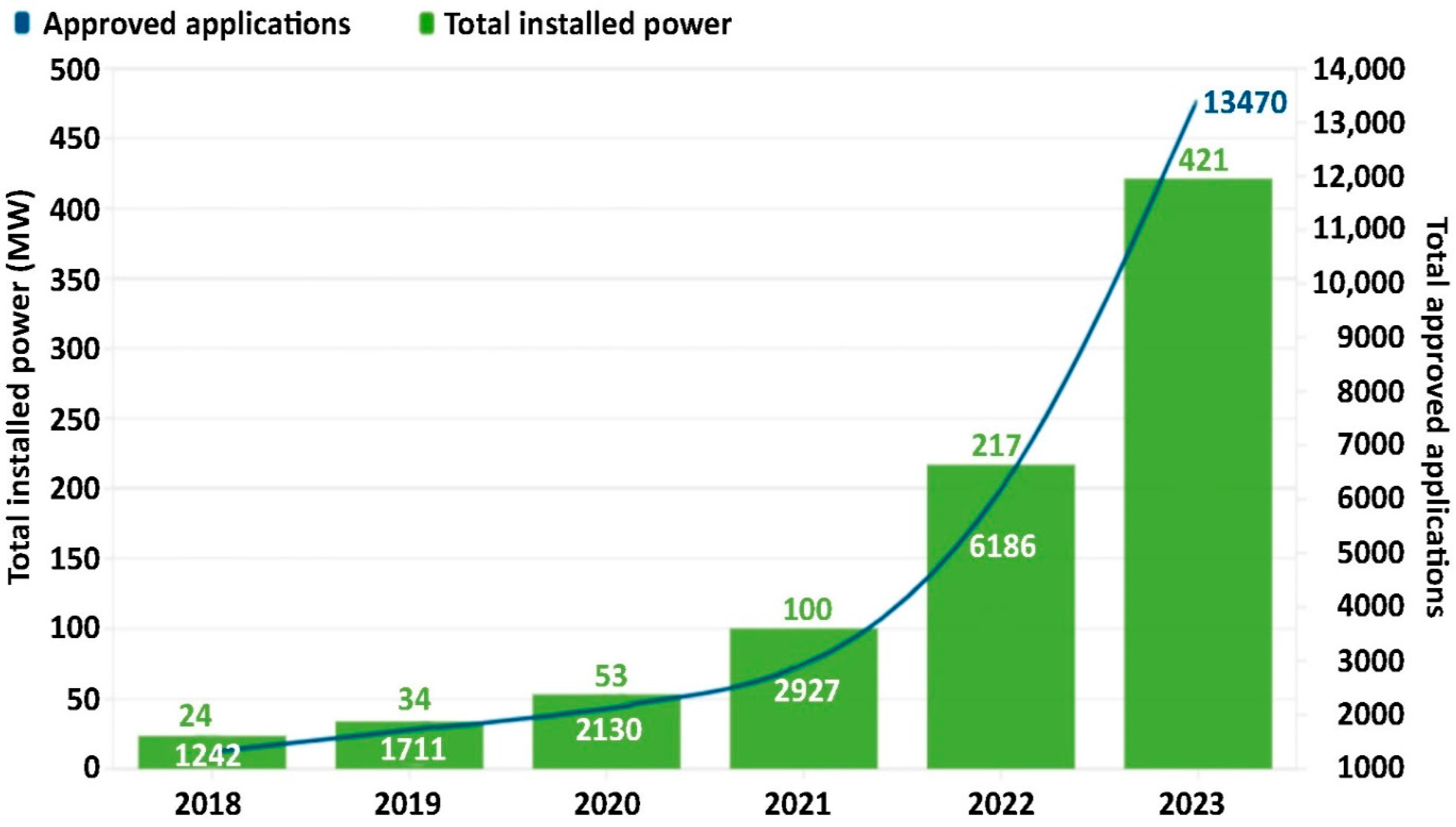
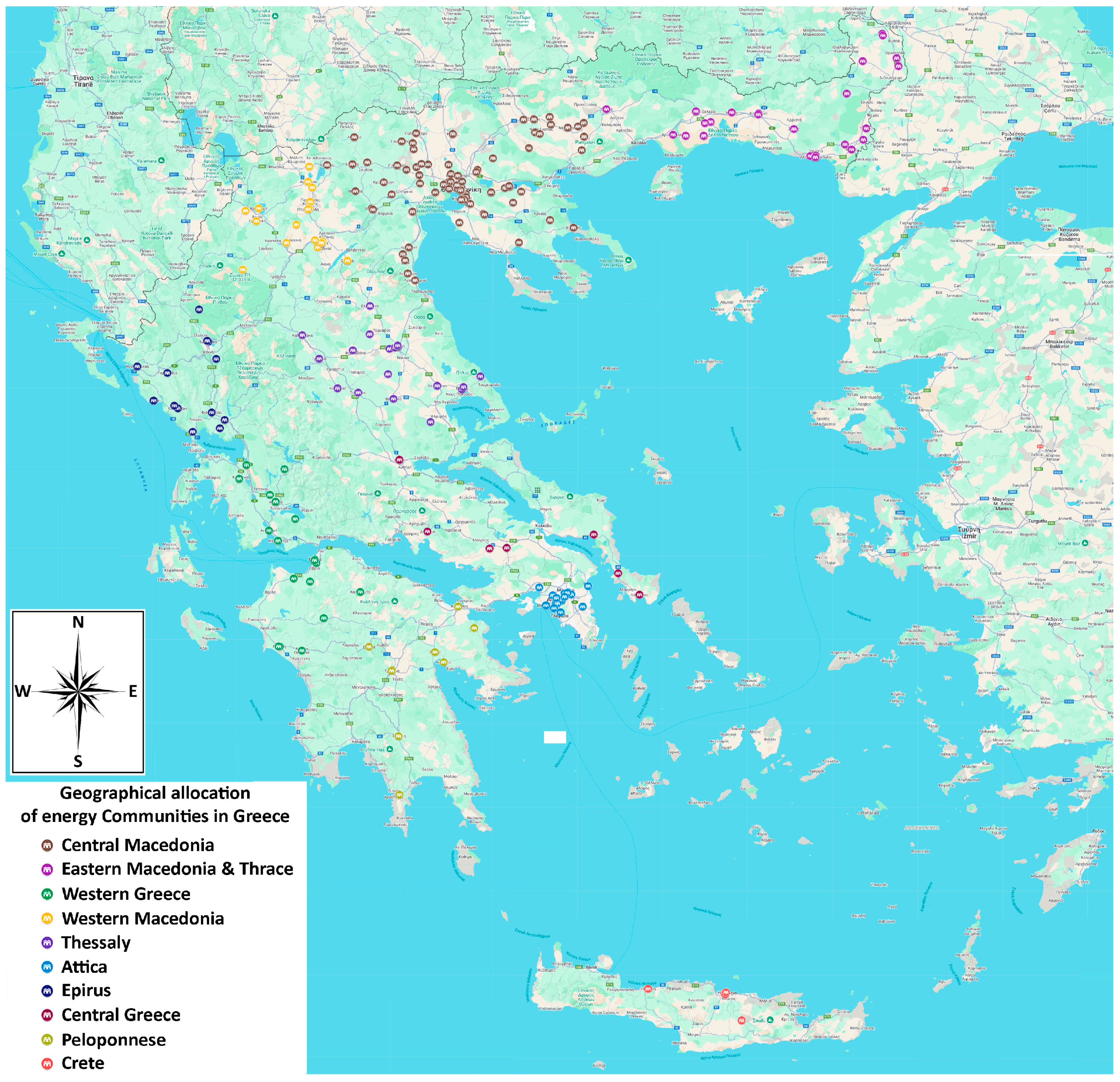
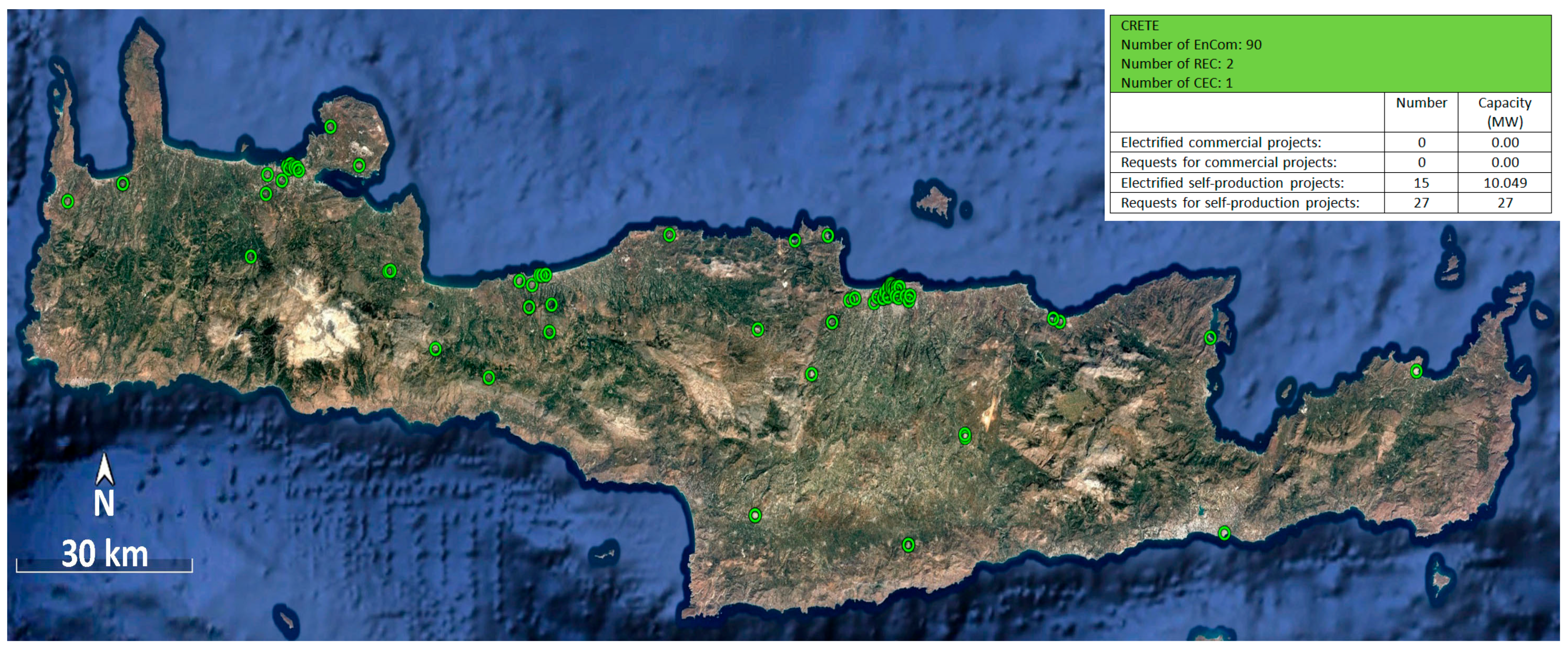

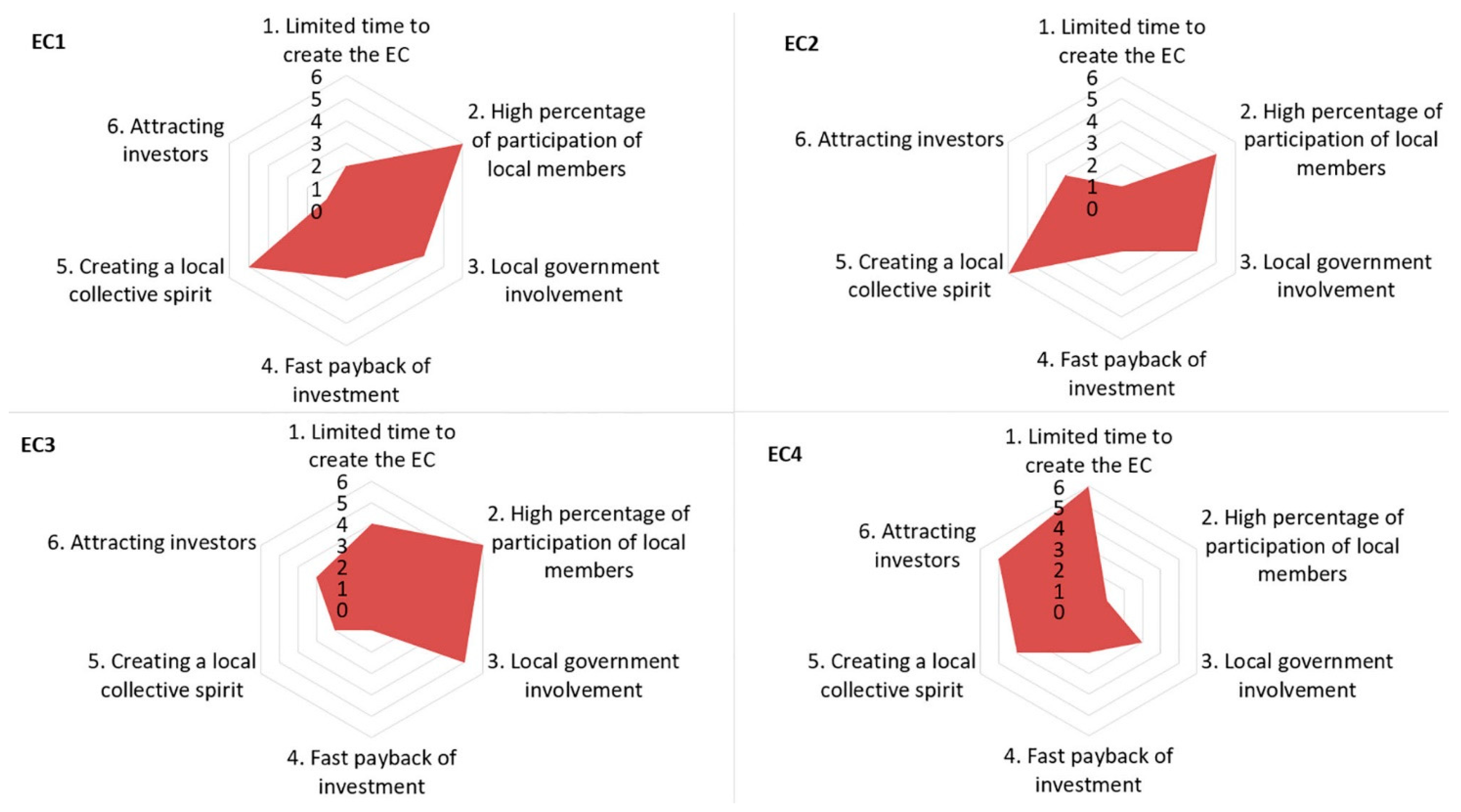
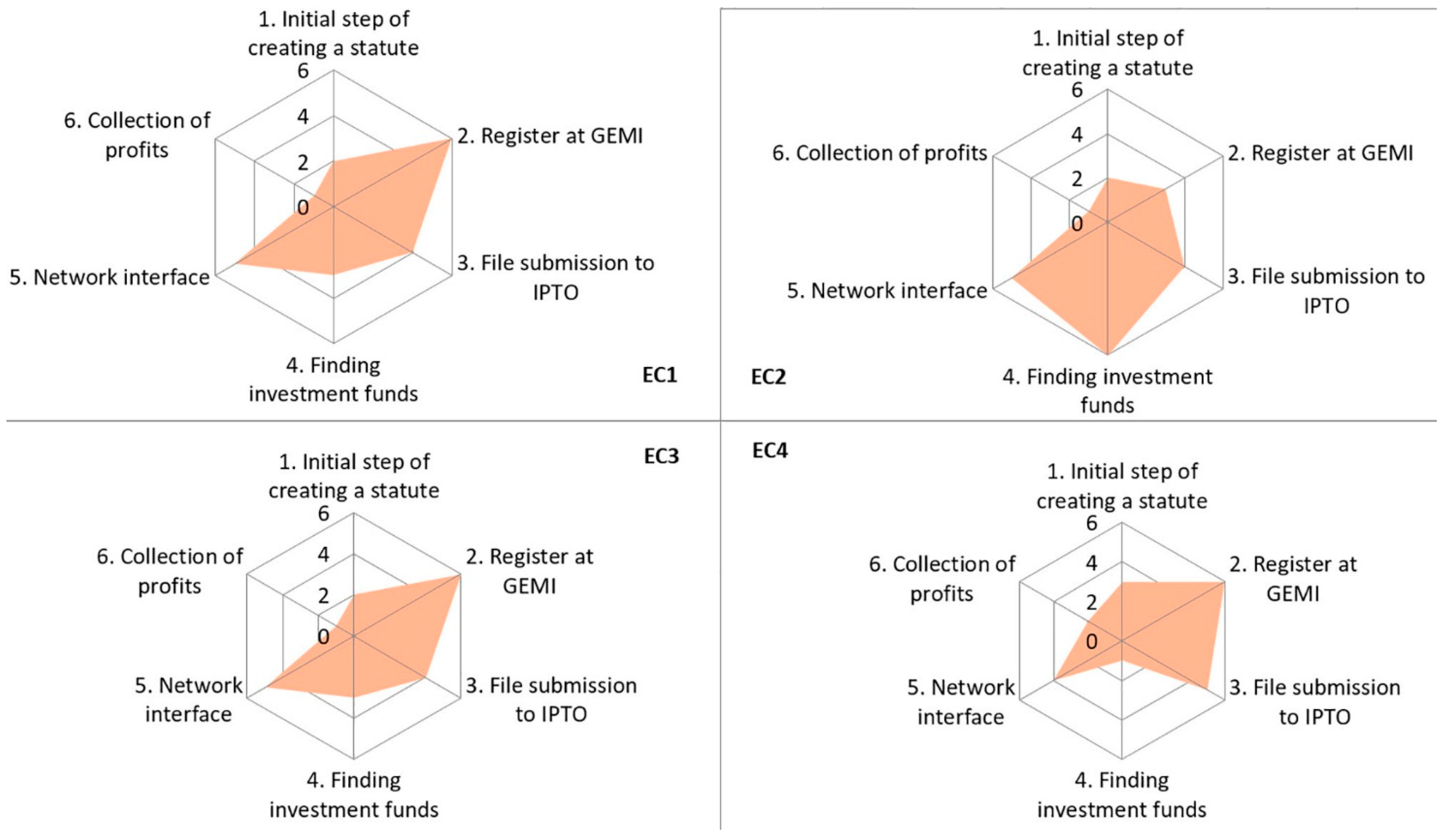
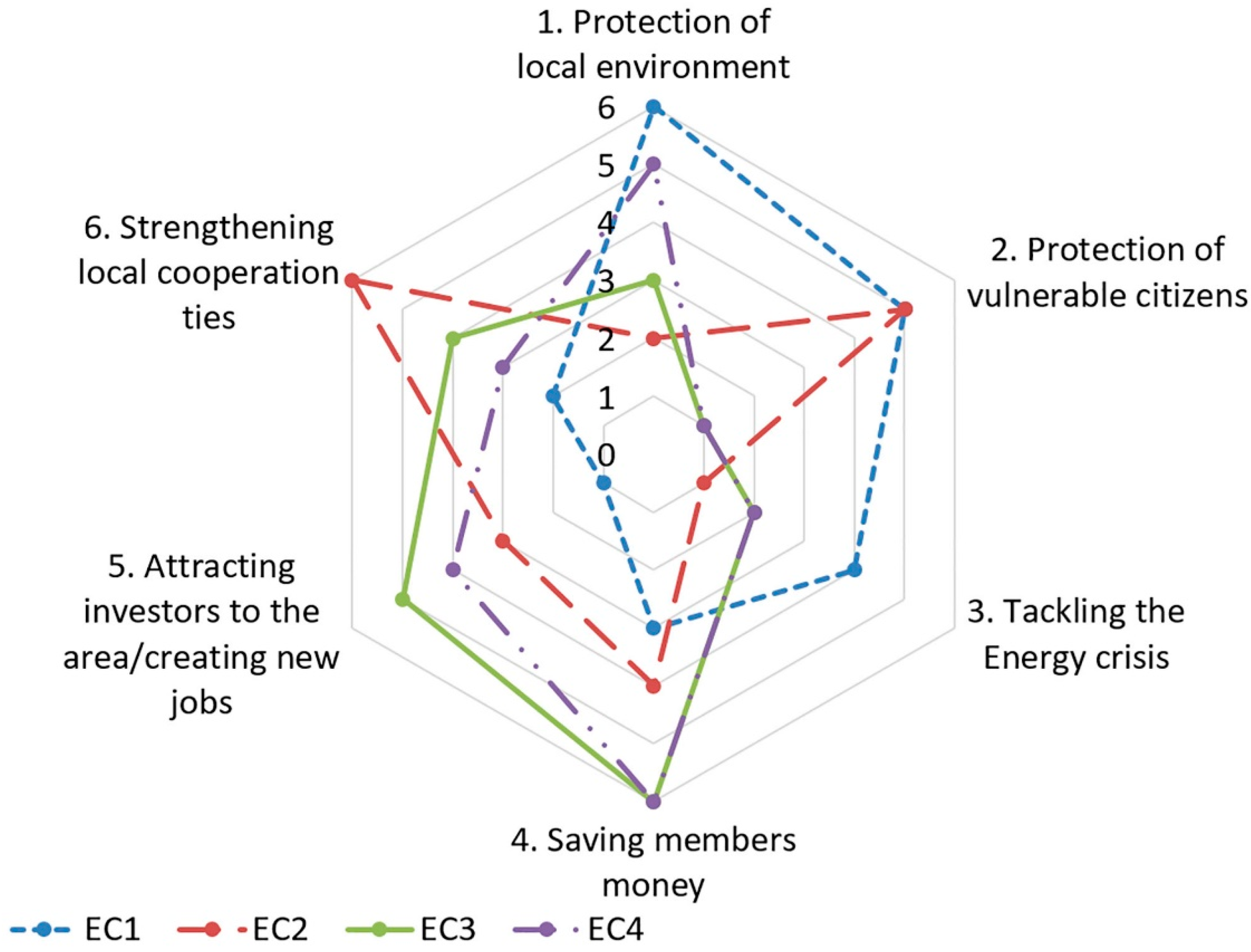
| Milestone | Description |
|---|---|
| Kyoto Protocol (1997) | While not specific to Europe, the Kyoto Protocol sets targets for reducing greenhouse gas emissions, which spurred European countries to take action [1]. |
| EU Climate and Energy Package (2008) | This package sets binding targets for EU Member States to reduce greenhouse gas emissions by 20% levels, increase the share of renewable energy to 20%, and improve energy efficiency by 20% by 2020 with regard to 1990 [2]. |
| EU Energy Efficiency Directive (2012) | This directive established binding measures to help the EU reach its 20% energy efficiency target by 2020 and laid the groundwork for subsequent policies and actions [3]. |
| Paris Agreement (2015) | Building upon the Kyoto Protocol, the Paris Agreement aimed to limit global warming at a maximum of 2 degrees Celsius above pre-industrial levels, with efforts to limit the temperature increase to 1.5 degrees Celsius. The EU, along with its Member States, committed to this agreement, further driving efforts to reduce CO2 emissions [4]. |
| European Green Deal (2019) | This is one of the most ambitious milestones ever. It aims to make Europe the first climate-neutral continent by 2050. The Green Deal includes various initiatives, such as the European Climate Law, which legally binds Member States to reach net-zero emissions by 2050, and the European Climate Pact, engaging citizens and stakeholders in the transition [5,6,7]. |
| Recovery and Resilience Facility (2020) | Part of the EU’s COVID-19 recovery plan, this facility allocates funds to Member States to invest in green and digital transitions, including energy efficiency measures and renewable energy projects [8]. |
| Fit for 55 Package (2021) | This package proposes a set of legislative measures to align EU climate and energy policies with the more ambitious 2030 targets, including increasing the share of renewable energy to 40–45%, improving energy efficiency by 36–39%, and reducing greenhouse gas emissions by at least 55% below 1990 levels by 2030 [9]. |
| No | Target Goal | NECP 2019 (2030 Targets) | NECP 2023 Revision (2025 Targets) | NECP 2023 Revision (2030 Targets) |
|---|---|---|---|---|
| EG1 | Greenhouse Gas (GHG), Land Use, Land Use Change, and Forestry (LULUCF) (change since 1990) | 40% | 41% | 54% |
| EG2 | GHG with LULUCF (change since 1990) | - | 44% | 57% |
| EG3 | RES penetration percentage over the gross final consumption of energy | 35% | 31% | 44% |
| EG4 | Energy efficiency | 0% | 4% | 5% |
| EG5 | Final land occupation | 16.5 | 16.6 | 15.4 |
| EG6 | RES—electro-production (% of gross electricity consumption) | 61% | 58% | 79% |
| EG7 | RES in heating and cooling | 43% | 36% | 46% |
| EG8 | RES in the transport sector | 19% | 13% | 29% |
| EG9 | Renewable fuels of non-biological origin (RFNBO) (% transport fuels) | 0% | 0% | 1% |
| EG10 | Advanced biofuels (% transport fuels) | 1.5% | 0% | 2.4% |
| EG11 | Conventional biofuels (% transport fuels)—upper limit | 1.7% | 1.7% | 1.7% |
| EG12 | Effort Sharing Regulation (ESR) (% GHG change in non-Emission Trading System (ETS) sectors) | 40% | 36% | 46% |
| EG13 | Reducing energy poverty in relation to 2016 (% reduced number of households meeting the above-mentioned conditions) | - | 50% | 75% |
| RES Participation in the Electricity Sector | NECP 2019 (2030 Targets) | NECP 2023 Revision (2025 Targets) | NECP 2023 Revision (2030 Targets) |
|---|---|---|---|
| Renewable energy sources, other than hydroelectric (GW) | 15.5 | 14.8 | 23.5 |
| Wind power (GW) | 7.1 | 6.0 | 9.5 |
| Solar power (GW) | 7.7 | 8.2 | 13.4 |
| Other RES (GW) | 0.7 | 0.5 | 0.6 |
| Hydroelectric (GW) | 3.7 | 3.1 | 3.8 |
| Electricity storage capacity (GW) | 2.7 | 3.3 | 5.3 |
| 1.25 | 1.9 | 3.1 |
| 1.4 | 1.4 | 2.2 |
| Capacity of units with burnt gas (GW) | 6.9 | 6.9 | 7.7 |
| Power of solid burnt units (GW) | 0.3 | 1.5 | 0.0 |
| Power of units with burnt liquid (GW) | 0.3 | 1.3 | 0.7 |
| Law | Description |
|---|---|
| Law 4416 (2016) | Introduction of net metering and virtual net metering targeting farmers and municipalities. |
| Law 4513 (2018) | Introduction of Energy Communities. |
| National Energy and Climate Plan (NECP) (2019) | Definition of quantitative targets for energy, reduction of emissions, heating and cooling, and renewable energy until 2030 and 2050. |
| Law 4643 (2019) | Liberalisation of the energy market, modernisation of Public Power Corporation, further support of RES systems, and privatisation of Public Gas Corporation. |
| Law 4710 (2020) | Promotion of electro-mobility and more. |
| YPEN-DAPEEK/74462/2976 (2020) | Definition of the licensing procedure for the installation and connection to the distribution network of small wind turbine stations with an installed capacity up to 60 kW, as well as any other details. |
| Law 4951 (2022) | Modernisation of the licensing process for renewable energy sources—Phase B of licensing of electricity production and storage framework for the development of pilot marine floating photovoltaic stations and more specific provisions for energy and environmental protection. |
| Law 4964 (2022) | Provision for the simplification of environmental licensing, establishing a framework for the development of offshore wind farms, dealing with the energy crisis, environmental protection, and other provisions. |
| Law 5037 (2023) | Renaming the Energy Regulatory Authority to the Waste, Energy, and Water Regulatory Authority, expanding its scope with responsibilities over water services and urban waste management, and strengthening water policy—Modernising the legislation on the use and production of electricity from renewable sources through the incorporation of EU directives 2018/2001 and 2019/944—Changes for energy communities. |
| National Energy and Climate Plan (NECP) (under development following the 2023 EU’s feedback) | Draft updated NECP 2021–2030 |
| ECs’ Activities | Activity Analysis | Energy Goals |
|---|---|---|
| Collective self-consumption | Collective self-consumption implies the instantaneous or near-instantaneous matching of production and consumption within a geographically confined area and between multiple consumers. | EG1, EG3, EG6, EG13 |
| Production | Production is often the primary activity of energy communities. This activity either stands alone or is combined with other activities, such as supply. | EG2, EG3, EG6, EG7 EG1 (indirectly), EG9, EG10, EG11 (perhaps in the future) |
| Supply | In the Clean Energy Package, the concept of multiple suppliers on a single metering point is depicted. This enables the supply of locally produced energy within the energy community while simultaneously allowing the consumer to select a conventional supplier for the energy that cannot be supplied by the community. | EG13 |
| Distribution | The Electricity Market Directive leaves open the option for member states to allow CECs to take over the distribution of electricity. There is no single right answer to whether this should be allowed or not. | Not applicable for NECP |
| Aggregation | Energy communities can aggregate the electricity produced by the production plants owned by the community, the consumption profiles of their participants and/or external customers, as well as the energy flexibility of their assets, and offer these aggregated loads collectively for purchase or auction in any electricity market. | EG12 |
| Sharing of electricity | The new directives enable energy sharing between the members of an EC. That implies that excess energy produced by one member or energy produced by a common asset can be used to supply other members. The conditions under which this will be allowed depend on the country and the rules agreed upon in the specific energy community. | EG12 |
| Energy-related services | Energy-related services can also be provided to the members of an EC, including the services of an EV charging card, a shopping guide for energy-efficient appliances, a mobile application to save energy, rental of power meters, subsidies for insulation and replacement or installation of heat pumps, consultancy services, energy auditing, consumption monitoring, energy monitoring, and management for network operations, etc. | EG1, EG4, EG7, EG8 |
| Tackle energy poverty | Energy communities can be an important way to meet the increasing electricity demand and alleviate energy-vulnerable or poor households by matching local production and demand, resulting in reduced electricity prices. | EG13 |
| No | Key Factor | Analysis | Source |
|---|---|---|---|
| 1 | Policy and Governance | To accurately forecast energy demand and guarantee sustainable energy usage, policymakers must create energy plans that take the Sustainable Development Goals (SDGs) into account. | [73,74] |
| The creation and execution of renewable energy projects require robust energy regulations and efficient governance. | [75] | ||
| Local authorities should adopt approaches that enable decision and policy makers to formulate optimal energy-related programs and concentrate on appropriate financial resources, considering the most suitable tools and anticipated impacts on the techno-economic performance of proposed projects. | [76] | ||
| 2 | Local policy and discourse networks | Local authorities ought to facilitate regional growth and job-creating investments, prioritising energy efficiency and sustainability, through the implementation of effective instruments by their technical departments. | [77] |
| The success of energy transitions is heavily influenced by discursive network structure and local policy initiatives. Discourse differences between urban and rural areas impact the advancement of energy efficiency and renewable energy initiatives. | [78] | ||
| 3 | Population Density and Energy Intensity | Improvements in energy intensity are impacted by population density. A higher density of city residents increases energy intensity, though population dispersion in rural areas decreases it. | [79] |
| Reducing CO2 emissions and promoting sustainable energy practices are two goals addressed by education and investment. | [80] | ||
| 4 | Firm-Level Energy-Saving Efforts | The attributes of fixed assets and firm-level variables like energy-saving initiatives are important in reaching energy-saving targets. Businesses with larger resource stockpiles are more effective at conserving energy. | [81] |
| 5 | Economic Conditions and Energy Management | Energy management strategies are influenced by economic factors, such as fluctuating and high energy prices. Technical hazards, financial constraints, and organisational priorities are some of the barriers. Collaboration, ongoing energy accounting, and energy-efficiency initiatives are success elements. | [82] |
| Carbon emissions, energy consumption, and economic growth are all related; in developing countries, energy use has a major influence on carbon emissions. | [83] | ||
| 6 | Investment Attractiveness and Energy Access | Energy accessibility and efficient energy management make agricultural businesses more interested in investing in a region, lowering risks, and improving sustainability. | [84] |
| 7 | Environmental Regulations | The effects of environmental laws on energy efficiency vary. Regulations drive a transition to cleaner energy in more developed areas and may encourage resource extraction in less developed ones. | [85] |
| 8 | Innovation Efficiency | Green productivity gains considerably from innovation efficiency. This connection is negatively impacted by financial constraints, indicating that strategies should be centred on developing green finance and increasing innovation efficiency. | [86] |
| Collaborative innovation efforts could be further reinforced by appropriate TRL approaches that would allow their enhancement by mitigating observed shortcomings. | [87] | ||
| 9 | Technical and Total Factor Energy Efficiency—Sustainability | Higher levels of technological and energy efficiency are found in the EU’s more developed regions. Innovation and human capital are essential for raising ecological performance and regional efficiency. | [88] |
| Energy efficiency is essential in reducing greenhouse gas emissions. | [89] | ||
| Export diversification in OECD countries helps improve energy efficiency and reduce energy intensity. | [90] | ||
| To guarantee energy security and sustainability, it is necessary to establish a balance between the utilisation of renewable resources and energy consumption. | [91] | ||
| 10 | Sustainable Development Goals (SDGs) and Energy Demand | To address the increased demand for energy, countries must incorporate the SDG targets into their energy planning. | [74,92] |
| 11 | Renewable Energy Development | Renewable energy adoption significantly reduces CO2 emissions, contributing to environmental sustainability. | [80,89] |
| Public acceptance, investments in the environment, and financial gains are important catalysts for the production of renewable energy; on the other hand, poor governance and insufficient government policies act as roadblocks. | [75] | ||
| A region should assess their optimal solutions, taking into consideration their special needs and future perspectives, as a sustainable strategy against possible future energy crises and relative price instability that will influence their economic profitability. Therefore, the implementation of algorithms for the use of batteries in order to minimise the capital expenditure (CAPEX) could ensure a sufficient percentage of self-sufficiency. | [93] |
| No | Environmental Dimension | Social Dimension | Economic Dimension |
|---|---|---|---|
| 1 | Increase Renewable Energy Deployment | Community’s welfare | Decrease energy production costs |
| 2 | Optimization of Resources | Community’s empowerment | Enhanced grid flexibility |
| 3 | Responsible use of resources by society | Community’s education | Sustain economic efficiency |
| 4 | Greenhouse gas emissions reduction | Addressing health and safety issues | Creating new infrastructure/jobs |
| 5 | Environmental sustainability | Energy Democratization | Increase community’s income |
| 6 | Local energy storage/Energy adequacy | Energy equity | Attract local investments—Business opportunities |
| 7 | Improve Resource efficiency | Social cohesion | Mitigate energy supply costs |
| ENV.D | S.D | EC.D |
| Phase | Preliminary | Fieldwork | |
|---|---|---|---|
| Source | Literature Review | Chambers of Commerce | Interviews |
| Purpose | To comprehend previous research’s findings and to locate preliminary evidence regarding the research question | To retrieve available data that would support this study’s second phase | To explore the validity and reliability of the obtained by the previous phase information and to expand them further if possible |
| Method | Secondary data | In-depth interviews | |
| Region | Total Number of ECs | Electrified Commercial Projects | Electrified Self-Production Projects | ECs with Electrified Projects |
|---|---|---|---|---|
| Region of Attica | 172 | 21 | 1 | 17 |
| Region of Central Greece | 116 | 151 | 1 | 52 |
| Region of Central Macedonia | 334 | 400 | 3 | 155 |
| Region of Crete | 93 | 0 | 15 | 5 |
| Region of Eastern Macedonia and Thrace | 125 | 254 | 3 | 67 |
| Region of Epirus | 62 | 86 | 2 | 28 |
| Region of Ionian Islands | 26 | 30 | 0 | 11 |
| Region of North Aegean | 5 | 0 | 0 | 0 |
| Region of Peloponnese | 80 | 70 | 18 | 33 |
| Region of Southern Aegean | 12 | 0 | 0 | 0 |
| Region of Thessaly | 180 | 327 | 0 | 86 |
| Region of Western Greece | 190 | 122 | 0 | 58 |
| Region of Western Macedonia | 294 | 127 | 1 | 46 |
| Total: | 1689 | 1588 | 44 | 558 |
| Interview Structure | KFs |
|---|---|
| 2, 3, 5, 6, 11 |
| 2, 4, 5, 6 |
| 2, 3 |
| 1, 2, 6 |
| 2, 3, 5, 6 |
| 4, 5, 6 |
| 2, 3, |
| 2, 3, 9, |
| 1, 2, 7, 8, 10 |
| 3, 4, 9, 11 |
| Profile | Region | Members | Activity |
|---|---|---|---|
| EC1 | Central Macedonia | Citizens/Women | One Electrified Project |
| EC2 | Western Macedonia | Public Authorities | One Electrified Project |
| EC3 | Southern Aegean | Citizens | One Electrified Project |
| EC4 | Crete | Citizens | Two Electrified Projects |
| KFs | ENV.D | KFs | S.D | KFs | EC.D |
|---|---|---|---|---|---|
| KF1, KF11 | 1 | KF3, KF5 | 1 | KF5, KF10 | 1 |
| KF9 | 2 | KF6 | 2 | KF9 | 2 |
| KF3, KF4 | 3 | KF1, KF2 | 3 | KF3, KF5 | 3 |
| KF11, KF9, KF7 | 4 | KF3, KF5 | 4 | KF11 | 4 |
| KF7, KF11 | 5 | KF1, KF2 | 5 | KF5 | 5 |
| KF5, KF9 | 6 | KF1, KF2 | 6 | KF6, KF11 | 6 |
| KF9 | 7 | KF1, KF2 | 7 | KF11, KF3 | 7 |
Disclaimer/Publisher’s Note: The statements, opinions and data contained in all publications are solely those of the individual author(s) and contributor(s) and not of MDPI and/or the editor(s). MDPI and/or the editor(s) disclaim responsibility for any injury to people or property resulting from any ideas, methods, instructions or products referred to in the content. |
© 2025 by the authors. Licensee MDPI, Basel, Switzerland. This article is an open access article distributed under the terms and conditions of the Creative Commons Attribution (CC BY) license (https://creativecommons.org/licenses/by/4.0/).
Share and Cite
Sofia, Y.; Katsaprakakis, D.; Sakkas, N.; Condaxakis, C.; Karapidakis, E.; Syntichakis, S.; Stavrakakis, G.M. The Role of Energy Communities in the Achievement of a Region’s Energy Goals: The Case of a Southeast Mediterranean Region. Energies 2025, 18, 1327. https://doi.org/10.3390/en18061327
Sofia Y, Katsaprakakis D, Sakkas N, Condaxakis C, Karapidakis E, Syntichakis S, Stavrakakis GM. The Role of Energy Communities in the Achievement of a Region’s Energy Goals: The Case of a Southeast Mediterranean Region. Energies. 2025; 18(6):1327. https://doi.org/10.3390/en18061327
Chicago/Turabian StyleSofia, Yfanti, Dimitris Katsaprakakis, Nikos Sakkas, Constantinos Condaxakis, Emmanuel Karapidakis, Stelios Syntichakis, and George M. Stavrakakis. 2025. "The Role of Energy Communities in the Achievement of a Region’s Energy Goals: The Case of a Southeast Mediterranean Region" Energies 18, no. 6: 1327. https://doi.org/10.3390/en18061327
APA StyleSofia, Y., Katsaprakakis, D., Sakkas, N., Condaxakis, C., Karapidakis, E., Syntichakis, S., & Stavrakakis, G. M. (2025). The Role of Energy Communities in the Achievement of a Region’s Energy Goals: The Case of a Southeast Mediterranean Region. Energies, 18(6), 1327. https://doi.org/10.3390/en18061327









